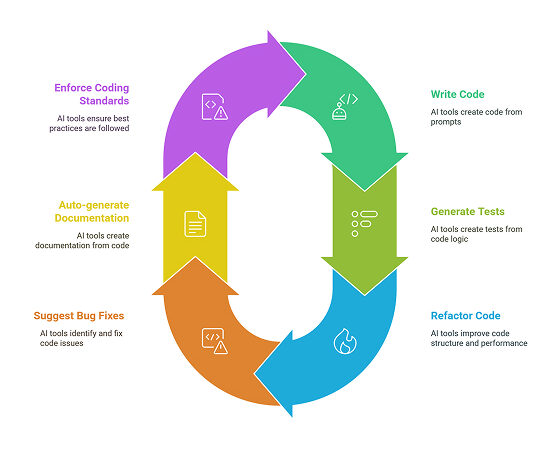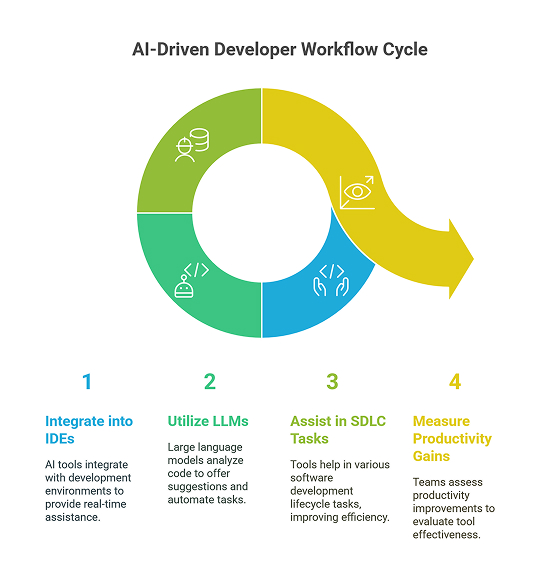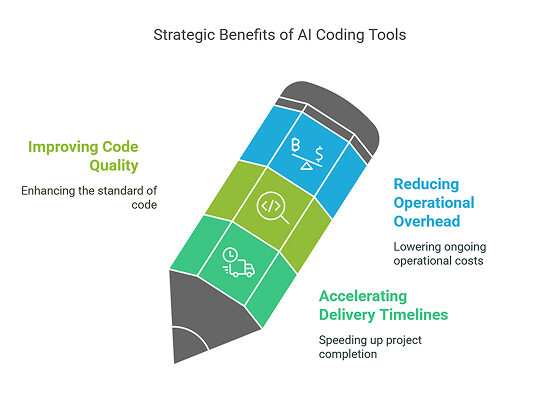Teams are expected to deliver more features, fix bugs quickly, and adapt to changing requirements while maintaining code quality and system reliability. As applications become increasingly complex, so does the pressure on developers to keep pace without burning out.
This is where AI coding automation is stepping in to bridge that gap.
These tools use machine learning models to assist with everyday development tasks like writing boilerplate code, generating tests, suggesting bug fixes, and even improving documentation.
What is AI Coding Automation?
AI coding automation refers to the use of machine learning-driven tools that assist developers throughout the software development lifecycle. These tools leverage large language models (LLMs) and code-specific training data to understand context, make intelligent code suggestions, and automate repetitive or low-value tasks.

These capabilities are embedded in popular IDEs, code review platforms, CI/CD pipelines, and developer portals, enabling seamless adoption without disrupting existing workflows. They speed up routine work and enable engineers to spend more time on system design, architectural decisions, and solving complex business problems.
Improving Coding Productivity Through AI
AI coding automation tools are reshaping developer workflows by integrating directly into IDEs, repositories, and CI/CD pipelines. These tools use transformer-based large language models (LLMs) fine-tuned on billions of lines of open-source code to assist with critical, time-consuming tasks in the software development lifecycle. The impact on productivity is measurable, especially when these tools are used consistently across teams.

Here’s a deeper look at how AI delivers productivity gains:
1. Accelerated Code Generation
Modern AI code assistants like GitHub Copilot and Amazon CodeWhisperer analyze the current cursor context language syntax, function signatures, and surrounding code and generate complete code suggestions in real time. For example:
- Given a function stub def get_user_by_id(user_id: str):, Copilot can generate a full implementation using an ORM or direct SQL query, depending on context.
- AI tools can scaffold entire class structures or REST API handlers in frameworks like FastAPI or Express.js based on minimal input.
This reduces the need for tab-switching to look up syntax, examples, or documentation, significantly speeding up feature development.
2. Boilerplate Elimination
In large-scale systems, boilerplate, such as dependency injection setups, API routing, error handling wrappers, and configuration scaffolding, are unavoidable. AI tools can auto-generate things such as:
- Swagger/OpenAPI documentation for REST endpoints.
- Redux boilerplate in React applications (action creators, reducers, etc.)
- Terraform module templates for common infrastructure patterns.
By programmatically generating repetitive code structures, developers avoid spending hours on mechanical work, reducing fatigue and freeing time for business logic.
3. Context-Aware Debugging
AI-enhanced debugging tools like Amazon Q Developer or integrated GPT-based assistants in platforms like Cursor and Replit analyze stack traces, execution logs, and source code to:
- Pinpoint the most likely root cause of a failure.
- Suggest targeted code modifications based on common error patterns.
- Walk through control flow and variable state inline in the IDE.
This is especially valuable in complex asynchronous or multithreaded environments where traditional debugging is time-intensive.
4. Test Generation and Validation
Tools like Diffblue Cover (for Java) and Qodo Merge (for Python/JavaScript) use static code analysis and symbolic execution to generate high-coverage unit tests with assertions. These tools can:
- Identify edge cases based on conditional branches.
- Automatically generate mocks and stubs for dependencies.
- Suggest parameterized test cases based on usage patterns.
AI-generated tests can improve test coverage and shift testing left in the SDLC, reducing post-deployment defects.
5. Automated Documentation Generation
AI can extract metadata, type hints, and function behavior to produce:
- Docstrings following Google or NumPy style guides.
- Markdown API reference documentation from codebases (e.g., for Python or Go).
- Architecture summaries or data flow diagrams from infrastructure-as-code scripts.
This improves maintainability, supports better onboarding, and reduces reliance on tribal knowledge in distributed teams.
6. Reduced Context-switching with IDE Integration
By embedding into JetBrains IDEs, VS Code, and even the command line (e.g., GitHub Copilot CLI), AI tools allow devs to:
- Generate code, tests, and docs inline without breaking flow.
- Ask natural language questions like “What does this function do?” or “Why is this failing?”
- Receive stack trace explanations without leaving the debugging console.
7. Task Acceleration Across the SDLC
When used holistically across coding, testing, code reviews, and deployment, AI helps devs to:
- Ship features faster with fewer regressions.
- Respond to incidents with faster root cause identification.
- Reduce cycle time from ideation to deployment.
This seamless integration reduces cognitive friction and helps developers stay focused on solving the problem at hand.
Scaling Development with AI Coding Tools
The productivity benefits of AI coding tools multiply when adopted across a team or organization. What starts as individual time savings for writing or debugging code can evolve into systemic advantages, accelerating delivery velocity, improving code quality, and scaling engineering output without linear increases in headcount.
Here’s how AI enables software development to scale more efficiently:
1. Faster Onboarding and Developer Enablement
AI coding tools can dramatically reduce the time it takes for new engineers to become productive.
- Autocomplete suggestions based on in-repo conventions help new hires learn project-specific patterns faster.
- AI-generated inline documentation helps developers understand legacy code without relying on tribal knowledge.
- Junior developers benefit from intelligent scaffolding and contextual guidance, enabling them to contribute high-quality code earlier in their ramp-up.
For example, a junior backend developer using Copilot or CodeWhisperer can implement API endpoints in Flask or Spring Boot with correct syntax and design patterns by leveraging AI context-aware completions, even without deep prior experience in those frameworks.
2. Promoting Standardization and Consistency
AI tools can help enforce best practices and architectural patterns across distributed or fast-growing teams.
- Code suggestions reflect idiomatic usage consistent with open-source standards and in-repo patterns.
- LLM-based reviewers (e.g., Qodo Merge) can flag anti-patterns, security flaws, or missing tests before code is merged.
- AI-generated infrastructure code (Terraform, CDK, Pulumi) will adhere to organizational templates, reducing drift and configuration sprawl.
This leads to cleaner, more maintainable code and simplifies collaboration across geographies and time zones.
3. Scaling with Fewer Resources
With AI taking over repetitive tasks-such as writing boilerplate, generating mocks, or updating documentation-teams can deliver more without proportionally increasing staff.
- Feature teams can move faster with fewer dependencies on specialized roles (e.g., QA engineers or technical writers).
- Incident response cycles shorten when AI helps trace bugs across services or auto-suggests rollbacks and fixes.
- CI/CD pipelines augmented with AI-driven test coverage analysis and static code checks reduce bottlenecks in delivery workflows.
This is particularly valuable for startups and scale-ups under pressure to deliver fast with lean teams.
4. Accelerating Cross-Team Collaboration
In larger engineering organizations, AI tools help eliminate silos.
- AI-generated architectural diagrams and code summaries enable faster context sharing between teams.
- Engineers working across services or domains (e.g., frontend touching backend or infra) get just-in-time explanations and scaffolds, reducing handover time.
- AI assistants embedded in documentation platforms or codebases answer natural-language questions about APIs, data contracts, or business logic-without waiting on subject matter experts.
This reduces context-switching overhead and allows parallel workstreams to progress while maintaining quality.
5. Enhancing Developer Satisfaction and Retention
At scale, developer burnout and turnover become major risks. AI automation alleviates much of the cognitive and operational burden.
- Less time spent on repetitive work increases job satisfaction.
- More focus on creative problem-solving improves engagement.
- Better documentation, test coverage, and tooling reduce friction in day-to-day development.
Investing in AI tooling isn’t just about speed; it’s about making the developer experience more sustainable and rewarding as the organization grows.
The ROI of AI Coding Automation
Adopting AI coding tools is not just a developer productivity play-it’s a strategic investment that delivers measurable returns across the software development lifecycle. From accelerating delivery timelines to improving code quality and reducing operational overhead, AI coding automation drives tangible improvements in engineering economics.

Here’s how ROI manifests in modern development environments:
1. Accelerated Time-to-Market
AI reduces development cycle times by automating common tasks such as:
- Writing boilerplate code (e.g., HTTP handlers, DTOs, serializers)
- Generating test suites and mocks
- Refactoring and documentation
This enables teams to move from ideation to production faster. For example:
- With GitHub Copilot, developers complete code segments up to 55% faster, according to GitHub’s 2023 impact study.
- Generative tools like Qodo Merge automate PR reviews and test suggestions, reducing review cycles by hours or days.
Faster iteration loops mean faster feature delivery, which directly impacts business responsiveness and revenue opportunities.
2. Improved Developer Output Without Headcount Growth
AI coding automation helps teams scale output without proportionally increasing team size. This is especially impactful in environments with limited hiring capacity or during budget constraints. Key drivers include:
- Reduction in time spent on repetitive tasks.
- Increased throughput per developer.
- Faster onboarding and contribution from junior devs.
Instead of hiring five new engineers, an organization can upskill two juniors with AI assistance and achieve comparable throughput-driving better cost efficiency per engineering hour.
3. Enhanced Code Quality and Maintainability
AI-powered test generation, static analysis, and documentation tools help catch issues earlier in the pipeline. Benefits include:
- Higher test coverage with fewer manual test cases.
- Early detection of anti-patterns and security vulnerabilities.
- Consistent documentation and inline comments.
For example, using Diffblue Cover for Java or CodiumAI for Python/JS can lead to >70% automated unit test coverage, dramatically reducing defect rates in production.
4. Reduced Context Switching and Cognitive Load
By integrating into IDEs and CI/CD workflows, AI tools eliminate the need to constantly switch tabs for documentation, code reviews, or debugging. This has a compounding effect on focus and throughput, allowing:
- Developers to stay in flow longer.
- Debugging and documentation to happen inline.
- Tasks to be completed with fewer mental hops.
This subtle but powerful improvement leads to faster delivery per ticket and higher quality, with fewer bugs introduced due to mental fatigue.
5. Lower Burnout and Turnover
Repetitive, mundane work is a major contributor to developer dissatisfaction and burnout. AI automation removes this burden in the following ways:
- Boilerplate, test writing, and doc generation are offloaded to machines.
- Developers spend more time on architecture, design, and problem-solving.
- Teams experience less cognitive overhead from inefficient tooling.
Conclusion
AI code automation is transforming software development by significantly boosting productivity, scaling development efforts, and enhancing code quality.
By automating repetitive tasks like writing boilerplate code and generating tests, AI allows developers to focus on more complex challenges, speeding up development cycles. It also accelerates onboarding and ensures consistency, enabling teams to scale without the need for additional headcount.
In essence, AI coding automation is a strategic asset that drives efficiency, cost savings, and higher-quality software, making it an essential tool for any organization aiming to stay competitive in today’s fast-paced development environment.


